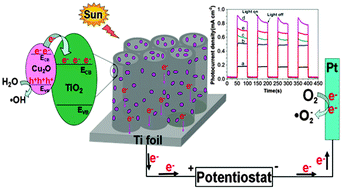Enhanced visible-light photoelectrochemical behaviour of heterojunction composite with Cu2O nanoparticles-decorated TiO2 nanotube arrays†
Abstract
Heterojunction composites based on n-type TiO2 nanotubes arrays (TNAs) coupled with p-type Cu2O nanoparticles were synthesized using a square wave voltammetry deposition method for in situ deposition of Cu2O nanoparticles onto the inner surfaces and interfaces of TNAs. The prepared samples were characterized by field-emission scanning electron microscopy, X-ray diffraction, X-ray photoelectron spectroscopy, transmission electron microscopy, energy-dispersive X-ray spectroscopy, and UV-vis spectroscopy. When compared with pure TNAs, the Cu2O–TNAs heterojunction composites exhibit considerably higher photocurrent density under visible-light irradiation and enhanced photocatalytic activity for the visible-light-driven photodegradation of methyl orange. Moreover, the photocurrent densities and photocatalytic activity of the Cu2O–TNAs heterostructures largely depend on the deposition potential which determines the content of the Cu2O nanoparticles. The Cu2O–TNAs prepared by the deposition potential of −1.0 V showed the highest photocurrent density (0.91 mA cm−2) and the largest photodegradation rate of methyl orange (88.8%) at the applied potential of 0.5 V under visible light irradiation. The enhanced photoelectrocatalytic activity can be attributed to reducing the recombination rate of the photoexcited electron–hole pairs in TNAs when coupled with Cu2O nanoparticles.


 Please wait while we load your content...
Please wait while we load your content...